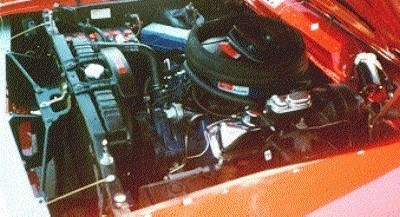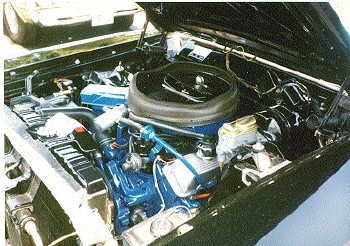
|
|||
428
 This is the engine that strikes fear in the hearts of the Bow Tie crowd. It should,
it knocked the drag racing world over in 1968 with a stunning win at the Winternationals
in SS/E with a 12.12 109.48 pass in the 1/4. This same engine is the Heart of the
fastest Fairlanes or Torinos in 68 and 69. For 68 it was a mid year option, available
April 1, 1968 and not many were built. For 69 it was standard for all Cobra's and
Cyclone CJ's and available as an option on all others. Think of the 428 as a more
Streetable 427. Heads are actually 427 Low-Risers with new exhaust manifold holes
drilled and provisions for smog fittings. Horsepower was rated at 335hp. This rating
is accurate at the RPM it was measured at. 428CJ made over 400HP easy. Ford choose
to advertise the 335 figure for several reasons 1) insurance 2) Super Stock Class
it would run in.
This is the engine that strikes fear in the hearts of the Bow Tie crowd. It should,
it knocked the drag racing world over in 1968 with a stunning win at the Winternationals
in SS/E with a 12.12 109.48 pass in the 1/4. This same engine is the Heart of the
fastest Fairlanes or Torinos in 68 and 69. For 68 it was a mid year option, available
April 1, 1968 and not many were built. For 69 it was standard for all Cobra's and
Cyclone CJ's and available as an option on all others. Think of the 428 as a more
Streetable 427. Heads are actually 427 Low-Risers with new exhaust manifold holes
drilled and provisions for smog fittings. Horsepower was rated at 335hp. This rating
is accurate at the RPM it was measured at. 428CJ made over 400HP easy. Ford choose
to advertise the 335 figure for several reasons 1) insurance 2) Super Stock Class
it would run in.
The following was taken from the 1969 Muscle Parts Catalogue. The information in the ( ) is added by me. The 428 "Thunderbird" engine came on the scene in 1966 to replace the 390 as the "heavy hauler" in Fords and Thunderbirds. It was quite, lightweight for its displacement, and put out over 300 "advertised" horsepower. Seeing this engine had potent performance possibilities, Ford performance engineers interchanged some parts from the ultra-hot 427, added some entirely new pieces, and came up with the 428 Cobra- Jet. (Actually the people at Tasca Ford did, but why split hairs) The 428 Cobra Jet features a controlled micro-structure, improved nodular cast iron block. 427 blocks use the same type of alloy cast iron to provide high strength characteristics. The crankshaft is also machined from nodular controlled cast iron, with main and rod journals identical to the 427 crank. (428 crank in 427 = 448 Cubes) Two different cranks are used to maintain balance with three differently weighted pistons. 1968 and 1969 engine built before 12-26-68 use a crank that maintains balance within tolerances with either 680 gram or 692 gram piston. Engines built after 12-28-69 use a crank that balances with 712 gram pistons for better durability. (CJ pistons have a tendency to break the side skirts) All pistons are aluminum autothermic design. The rod is forged steel with caps retained with a nut and bolt design. 428 Cobra Jets coupled with a 3.90 or 4.30 ratio axles use some different lower-end pieces as explained under 428 Super Cobra Jet. All 428CJ cylinder heads feature large 2.34" x 1.34" rectangular ports and big valves 2.097" dia. Head-intake, and 1.660" dia. Head exhaust that provide excellent breathing. A big Holley 4-bbl carburetor, flow rated at 735 cfm, sits atop a free breathing cast iron manifold. It's short, smooth runners are designed in a dual plane 180 ° configuration just like the aluminum Police Interceptor version for efficient air/fuel mixture delivery to combustion chambers. This setup does such a great job that the only induction changes recommend for any of the 428 Muscle Kits is the substitution of the Aluminum manifold to obtain better breathing and reduce weight upfront. (Actually good for 5hp or so, the 427 "sidewinder" would be the best choice for Factory performance. Both eliminate about 55 pounds from the engine!) Super 428 Cobra Jets use the same pieces as standard 428 CJ's except for some different lower end goodies. The rod is the 427 forged type with cap screws for better durability (LeMans Rods). Two crankshafts are used; one with 692 gram pistons before 12-26-68, and another with 712 gram pistons after 12-26-68. This requires cranks with different balance weight, along with appropriate flywheel, damper and spacer counterweights to accommodate the different piston weights. Do not interchange Super Cobra Jet parts with each other, or with standard Cobra Jet pieces or imbalance will result. Super Cobra Jet 428's also used an external oil cooler in front of the radiator. The 428 Super CJ components come standard when the vehicle purchased with 3.90:1 or 4.30:1 rear axle ratio. (This is now known as the Drag Pak option. It was Fords way to try and reduce warranty work. There are no published differences in HP between the two. I feel that the standard CJ would show more HP on a Dyno due to the lighter reciprocating mass.) Thus if you get an axle that lets you wind up in a short distance, you also get a bit stronger lower end. Here's how to identify these two engines so you won't run afoul when ordering or changing parts.
Standard 428 Cobra Jet - 418S, 419S, 420S, 421S Super 428 Cobra Jet - 422S, 423S, 424S, 425S (these tags can be reproduced)
C6ME-A C7ME-A C8ME-A - This one has three heavy main webs. The others have only two. I wouldn't let the two main webs bother you. The majority of the time when a 428 motor blows it can be traced to a valve. Very seldom is the block at fault. Some other unique parts to a 428CJ are:
Intake Manifold: C8OE-9425-C. Cast Iron Exhaust Manifolds: C8OE-9430-A or B -RH C8OE-9431-A or B - LH Carb: 68 1/2 = C80F-9510-AA 4 Speed. C80F-9510-AB Automatic - Note only Automatics were placed in mid-sized cars. Carb: 69 = C9AF-9510-M 4 Speed C9AF-9510-N Automatic C9AF-9510-H Automatic C9AF-9510-U Auto/4Speed - Replacement Part HOW TO SEE IF YOUR BLOCK IS ORGINAL One of the most often asked question is "Is my motor the one that came from the factory". This is also what the hobby calls numbers matching. Many people don't realize that Ford did stamp the VIN number on the block. Though it can be a real pain in the rear to read, it is visible. If the motor is not out of the car you will have to use a small mirror. Look on the back of the number eight cylinder right where the Head meets the block. There is a small raised boss there. If your motor is original you will see a partial VIN there. My Cobra's Vin is 9K45R135165. On my block the number appears as 9K135165. This is the same for all FE motors in Torinos/Fairlanes ie. 390's. Other models may be the same but I don't track that. You'll also find the Vin number stamped on the Transmission case and the inner fender supports, You'll have to remove the drivers or passenger side fender to see it. Also if you go looking for a CJ or a SCJ block at swap meets there is a real easy way to id them. All CJ and SCJ blocks have a raised welded mark on the back side of the block from my observations of orginal cars only. The flywheel or flexplate needs to be removed to see it. A CJ will what looks like a raised welded "C" and SCJ will have an "A". These marks look like thewy were done by hand so don't look for nice clean lettering. These marks were for assembly so the correct crank and rods were installed. I have seen SCJ blocks from a numbers matching car with the thinner webbing so not all SCJ were the strongest blocks. Also on all numbers matching Cobra's I have been involved with each CJ block had a C on the back and each SCJ had an A. On some blocks there is a 428 cast in the water jacket. I have only seen this on one block others were all blank. Here is a picture off both a 428Cj and 428 SCJ both are from 1969 Cobras 
This is a CJ motor in a 69 Cobra fastback. Note the Chrome Valve covers and breather cap. The master cylinder cover is aftermarket, not factory. This car also has power steering, you can just see the top of the bracket. Car is a Ram Air car but the Smog has been removed.  The is 428 SCJ from a 69 Cobra Hardtop. Master cylinder cover is again wrong. Value
Covers a finned Aluminum. (This does not indicate at SCJ) The visual cue this is a
SCJ the external Oil Cooler located just in front of the radiator. Also note in both
photos the presence of the battery hold down support attached to the fender. CJ motor
has it in the correct hole the SCJ is wrong if your going for Concourse quality. Also
notice the Smog setup on the SCJ. This was not just for Calf. Cars as many people
think. All 428's came with a smog pump no matter where they were sold. One more note
the high gloss black paint on the engine compartment is wrong. It should be a 30%
gloss which is slightly duller than a semi gloss. Any paint store could mix it for
you. I found that Por-15's chassis black is close enough.
The is 428 SCJ from a 69 Cobra Hardtop. Master cylinder cover is again wrong. Value
Covers a finned Aluminum. (This does not indicate at SCJ) The visual cue this is a
SCJ the external Oil Cooler located just in front of the radiator. Also note in both
photos the presence of the battery hold down support attached to the fender. CJ motor
has it in the correct hole the SCJ is wrong if your going for Concourse quality. Also
notice the Smog setup on the SCJ. This was not just for Calf. Cars as many people
think. All 428's came with a smog pump no matter where they were sold. One more note
the high gloss black paint on the engine compartment is wrong. It should be a 30%
gloss which is slightly duller than a semi gloss. Any paint store could mix it for
you. I found that Por-15's chassis black is close enough.
|
|||
| www.fairlaneregistry.com © 2000 fairlaneregistry.com LLC | |